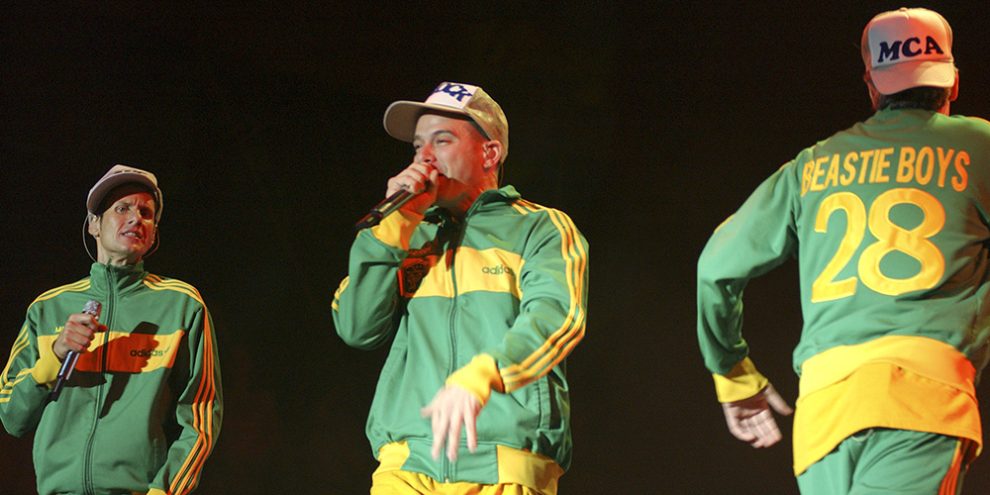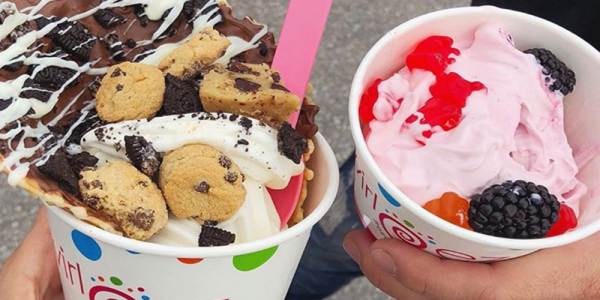
By Stephanie Horak
The birth of MTV in 1981 changed the game of the music industry. The art form of the music video was born and the importance of image became even more powerful. Nothing defined this new art form like Michael Jackson’s 1982 music video for “Thriller”. Produced in partnership with MTV, the video set viewers’ expectations high with its technically advanced visual narrative, massive budget and Hollywood director.
The ’90s was a decade filled with music videos that both challenged and delighted the viewer. Some pushed boundaries and some were unlike anything we’d ever seen before. A single video could take an underground emerging genre to the masses; it could ignite fashion trends and inspire technological and design innovation; it could act as a political statement or a glimpse into another world but ultimately, it could sell millions of records.
Below is our list of 25 music videos that are iconic in their ability to capture the essence of ’90s pop culture.
“FREEDOM! ’90” – GEORGE MICHAEL (1990)
“CRYIN'” – AEROSMITH (1993)
You can’t think of ’90s music videos and not picture Alicia Silverstone flipping the bird to her ex-boyfriend as she jumps off an overpass. Everything about this video screams ’90s: plaid shirts, Doc Martens, t-shirt dresses, belly-button piercings (the video is said to have sparked the naval piercing craze), not to mention 16-year-old Alicia Silverstone herself. “Cryin'” was the first of three Aerosmith videos for Silverstone including “Amazing” (1993) with Jason London and “Crazy” (1994) with Liv Tyler (1994).
“PRAISE YOU” – FATBOY SLIM (1999)
Spike Jonze’s 1999 video for “Praise You” was the first glimpse of the concept of a flash mob. The craze would begin later in the 2000s with the emergence of YouTube but in 1999, no one had seen anything like it. After sending Fatboy Slim his solo dance video for “The Rockafeller Skank”, Jonze landed creative control for the “Praise You” video. Shot on a camcorder in guerrilla style, assistant director Roman Coppola recorded Jonze (performing as “Richard Koufey”) leading the fictional Torrence Community Dance Group in a routine outside of a California movie theatre. Fatboy Slim can be seen at the end of the video when he looks into the camera as Jonze describes his “b-boy moves.”
“NOTHING COMPARES 2 U” – SINÉAD O’CONNOR (1990)
Sinéad O’Connor’s video for her version of Prince’s “Nothing Compares 2 U” is one of the most iconic videos of all time. The intimate video won multiple awards at the MTV Music Video Awards including the coveted Video of the Year Award making O’Connor the first ever female recipient. The power of “Nothing Compares 2 U” lies in its loneliness: the dark empty background, grim lighting, footage of O’Connor walking alone through Paris’s Parc de Saint-Cloud and most effectively, the extended closeup shots that intensify the emotion that floods her face. The moment her real tears appear and fall down her face makes this video captivating 27 years later.
“BIG ME” – FOO FIGHTERS (1996)
The video for the Foo Fighters’ single “Big Me” captures two moments in ’90s pop culture history: cringeworthy Mentos commercials and the emergence of the Foo Fighters. After writing and recording the entire debut Foo Fighters album himself in an effort to heal from the death of Kurt Cobain, the self-titled record was the first music most Nirvana fans heard from Grohl. While much of the album stays true to the grunge-rock genre, “Big Me” is something completely different. The fourth single is ultra pop and became a crossover hit for the band. Embracing the jingle-like melody of the single, the band agreed to a parody video concept. Replacing Mentos with Footos, the band mocked the corny Mentos commercials and created what would be the first in their series of hilarious music videos.
“WATERFALLS” – TLC (1995)
TLC’s second No. 1 single came with 1995’s “Waterfalls.” Written by Lisa “Left Eye” Lopez, Organized Noise, and Marqueze Etheridge, “Waterfalls” deals with the widespread ’90s issues of HIV/AIDS, drug crime and drug-related murder rates. “Waterfalls” is said to be the first No. 1 song in which the AIDS epidemic is specifically referenced in the lyrics.
“CRIMINAL” – FIONA APPLE (1997)
“Criminal” was one of the most controversial videos of the ’90s. Although it was the fifth single from Fiona Apple’s debut album Tidal, it was the breakout track of the record. Scenes of an extremely thin 19-year-old Apple shedding her clothing, laying in the laps of half-naked men and lying naked in a bathtub sparked slut-shaming against her in the media as well as accusations of promoting the gaunt heroin-chic body trend of the ’90s. Apple defended her video by revealing in 1998 that after she was raped at age 12, she had developed an eating disorder in order to get “rid of the bait that was attached to my body” and that doing the “Criminal” video was a way for her to face her insecurities.
“EVERYBODY HURTS” – R.E.M. (1993)
Written by R.E.M. drummer Bill Berry, “Everybody Hurts” addressed the issue of suicide, the sixth-highest cause of death in the U.S. at the time. Focused on the message of the song, director Jake Scott (son of director Ridley Scott) displayed subtitles of the lyrics throughout the subtitled thoughts of strangers who sit stuck in a traffic jam. As thoughts like, “You die. You turn to dust,” “I’ll talk when I want to,” and “Leave me alone” appear, Berry’s empathetic lyrics respond on the screen with phrases like, “sometimes everybody cries” and “everybody hurts sometimes.” As the chorus repeats “hold on,” everyone gets out of their cars and disappears walking the Texas Interstate together.
“SABOTAGE” – BEASTIE BOYS (1994)
Spike Jonze upped the ante of the badass Beastie Boys track “Sabotage” with the visual element of ’70s-style cop show action sequences. The combination of Jonze’s camera angles, car stunts, and chase scenes are the perfect visuals for the explosiveness of the song’s dynamics. The retro costumes, wigs and moustaches worn by The Beastie Boys as they portray various fictional characters gives the video a ridiculous humour making it even more engaging to watch. After losing in each of the five categories the video was nominated in at the 1994 MTV Music Video Awards, MCA rushed the stage in his Nathaniel Hornblower disguise from the video and interrupted Michael Stipe’s speech, protesting the fact that “Sabotage” had failed to receive any awards. 15 years later the video won the Best Video (That Should Have Won a Moonman) Award.
“BUDDY HOLLY” – WEEZER (1994)
Spike Jonze strikes again with the nostalgia-soaked Weezer video for “Buddy Holly.” With its hand claps and lyrical references to ’50s icons Mary Tyler Moore and Buddy Holly, the video is right at home in Arnold’s Diner from the set of Happy Days. After tirelessly sorting through episode footage, Jonze edited clips of the cast around actor Al Molinaro’s cameo and footage of the band creating a seamless blend of three eras: ’90s music, ’70s television, and ’50s fashion.
“KARMA POLICE” – RADIOHEAD (1997)
Radiohead’s music video for “Karma Police” is one of the band’s most memorable music videos. Director Jonathan Glazer (who also directed “Street Spirit (Fade Out)“), called the video a failure at the time, explaining that his attempt to have subjective, minimalist camera use and to create something hypnotic and dramatic from a single perspective wasn’t achieved. Fans disagree. 20 years later, the video is still as captivating as it was in 1997. It was reported that Glazer had originally pitched the video idea to Marilyn Manson. Luckily fate intervened saving the concept for the well-matched lyrics of “Karma Police.” From the perspective of the driver’s seat, we participate in the hunting down of a man running from the car on a country road as Thom Yorke loosely mouths the lyrics in the back seat. After finally collapsing, the man realizes the car is leaking fuel and sets the car ablaze as the viewer’s last perspective is from within the burning car. Yorke himself collapsed during the making of the video. Rumour spread that the lethargic Yorke had been accidentally inhaling carbon monoxide through the car’s air-conditioning system and that after filming he fainted and nearly died.
“AROUND THE WORLD” – DAFT PUNK (1997)
The music video for Daft Punk’s “Around The World” is immediately mesmerizing in its design and intricate choreography. Directed by Michel Gondry (also known for The Chemical Brothers’ “Let Forever Be”, Bjork’s “Bachelorette” and “Everlong” by the Foo Fighters), the video features groups of dancers representing the different instruments in the song: The robots represent the singing voice, the tall athletes in tracksuits with small prosthetic heads symbolize the bass guitar, the synchronized swimmers represent the high-pitched keyboard, the skeletons symbolize the guitar line and the mummies represent the drum machine. Gondry wrote in the liner notes of his DVD set, “If I had to pick one of my videos to be the favorite one, this one could do.”
“ROLLER COASTER” – RED HOT CHILI PEPPERS (1996)
Two icons of the ’90s joined forces in 1996: Red Hot Chili Peppers and Beavis and Butt-Head. Created for the soundtrack of Beavis and Butt-Head Do America, the Red Hot Chili Peppers covered “Love Rollercoaster” — a funk original by the Ohio Players in 1975. The animated video captures the reckless rock-and-roll reputations of both the cartoon duo and the band (with Jane’s Addiction’s Dave Navarro replacing guitarist John Frusciante) as Flea free-falls off a roller-coaster, Beavis breathes fire, Butt-head destroys a city, head-banging ensues and they all end up naked in the end of the animated ’90s chaos.
“BITTER SWEET SYMPHONY” – THE VERVE (1997)
Who knew a dude walking down a street could be so enthralling? What makes the video for The Verve’s “Bitter Sweet Symphony” so effective is its direction. Created as an homage to Massive Attack’s “Unfinished Sympathy”, director Walter A. Stern created the feel of a single continuous shot with over 50 takes. Lead singer Richard Ashcroft walks down a London street without changing his pace or direction bumping fellow pedestrians, knocking a woman onto the ground, walking over the hood of a car, only stopping once for a moving car in his path. The video ends with the rest of the band joining him and becomes the shot that would be the starting point for their next music video, “The Drugs Don’t Work.”
“LET FOREVER BE” – THE CHEMICAL BROTHERS FEAT. NOEL GALLAGHER (1999)
Daft Punk director Michel Gondry returns to our list for the stunning visual of “Let Forever Be” by The Chemical Brothers featuring Noel Gallagher. Gondry created a mind-blowing kaleidoscopic dream world in which a girl’s nightmares are visualized with elements of surrealism, Busby Berkeley-inspired choreography and the manipulation of dimension and scale. Instead of using digital effects to depict multiplying objects, Gondry used real objects, dancers and choreography to create the flaring and kaleidoscope effects throughout the video.
“VIRTUAL INSANITY” – JAMIROQUAI (1996)
Director Jonathan Glazer appears on our list again for the mind-bending music video for “Virtual Insanity.” Jamiroquai’s most well known video, it blew the MTV Music Video Awards away with 10 nominations and four wins including Breakthrough Video, Video of the Year, Best Cinematography and Best Special Effects. Throughout the video Jamiroquai’s Jay Kay glides along a floor that appears to move in all directions underneath of him while furniture slides around the room. Though the floor appears to be moving throughout the video, it is actually the set that moves, creating an optical illusion. While the moving set manipulates the space, Jay Kay’s presence and smooth choreography creates a focal point for the viewer that only adds to the fascination of the video. Watch Glazer describe how he made “Virtual Insanity.” here
“NO RAIN” – BLIND MELON (1993)
Two words: Bee Girl. Blind Melon’s “No Rain” became one of the most played music videos on MTV in its time thanks to Heather DeLoach’s portrayal of a little tap-dancing girl in a homemade bee costume. The video begins with the girl being laughed at after she performs a tap dance at a talent show. After crying onstage she wanders the streets meeting strangers until she eventually comes a gated field where Blind Melon is playing. Seeing a group of people dancing in bee costumes, the girl is overjoyed to have found people like her. Although the song has an upbeat melody, the lyrics of “No Rain” deal with themes of loneliness, depression and the longing for happiness. The little girl’s journey throughout the video reflects both emotional elements of the song – the yearning to feel accepted as well as the joy felt in the music itself. The “No Rain” video inspired Pearl Jam’s 1994 song, “Bee Girl.”
“DOO-WOP (THAT THING)” – LAURYN HILL (1998)
Lauryn Hill’s video for “Doo-Wop (That Thing)” is an ode to the roots of the neo soul movement with the visualization of both ’60s soul and ’90s hip-hop culture. Shot with a split screen, the video portrays block parties from two different eras. The Lauryn on the left is the doo-wop queen singing the soft backing vocals and performing choreographed dance moves while the Lauryn on the right delivers the song’s rap lyrics and has the swagger of a hip hop artist in her performance.
“BLACK OR WHITE” – MICHAEL JACKSON (1991)
Michael Jackson’s “Black or White” video was premiered simultaneously in 28 different countries, resulting in a record-breaking 500 million viewers. The “Black or White” video is full of ’90s pop culture with cameos by Tyra Banks, Cheers star George Wendt and Macaulay Culkin in a bedroom with posters of Bart Simpson and Wayne Gretzky. Described as “a rock ‘n’ roll dance song about racial harmony” by Jackson’s label Epic, the video features Jackson dancing with various cultures around the world. What made the video so memorable was the morphing technique used as actors of different races and genders sing the chorus and seamlessly transform into each other. The extended version of the video in which Jackson morphs out of a black panther and begins a 4 minute dance sequence in which he grabs his groin, zips up his pants, smashes windows, trashes a car and blows up an inn created controversy and caused networks to ban the last section of the video.
“VOGUE” – MADONNA (1990)
With her music video for “Vogue,” Madonna and director David Fincher brought the voguing scene from underground New York gay clubs to the mainstream. The song brought disco back from the dead and ushered house music into popular music. The video pays homage to photographer Horst P. Horst’s famous photographs from the ’30s as well as legends from Hollywood’s golden era as Madonna lists glamorous icons like Bette Davis, Ginger Rogers, and Grace Kelly in the lyrics. The iconic Jean Paul Gaultier cone bra designed for her Blonde Ambition Tour made its first public appearance in “Vogue.”
“IRONIC” – ALANIS MORISSETTE (1996)
The video concept for “Ironic” is super simple but, man, did it work. Nominated for six MTV Music Video Awards, the video took home three wins at the 1996 ceremony. The multiple versions of Morissette singing together in a car amplified the irresistible sing-along quality of the song’s chorus. After bursting onto the mid-’90s music scene with the intensity of “You Oughta Know” and “All I Really Want,” this light-hearted video was an extension of the playful lyrical style of Morissette’s third single, “Hand In My Pocket.” “Ironic” went on to win a Juno Award, two Grammy nominations and become Morissette’s highest-charting single to date.
“WANNABE” – SPICE GIRLS (1997)
The Spice Girls stormed into the pop world with their video for “Wannabe” bringing their message of “Girl Power” with them. The video, completed in one continuous shot, captured the free-spirited, rambunctious energy of the all-girl group. Filmed in London, the video shows the girls crashing the Midland Grand Hotel dressed in the signature styles of their Spice Girl identities: Sporty, Scary, Ginger, Posh and Baby Spice. “Wannabe,” written in 30 minutes in their first professional songwriting session, was found to be the most recognizable song of the past 60 years according to a 2014 study by the University of Amsterdam. Their album, Spice, became the best-selling album by a female group in history and one of the most successful albums of all time. For a group whose original lineup was broken-up within two years of “Wannabe”‘s U.S. release, their domination of the pop world with two platinum albums and a feature film that broke the record for the highest-ever weekend debut on Super Bowl weekend grossing over 77 million dollars is pretty remarkable.
“MY NAME IS” – EMINEM (1999)
The video for Eminem’s debut single “My Name Is” introduced the world to one of the most controversial entertainers in music history. Rapping lyrics like “I’ll f*ck anything that walks / When I was little I used to get so hungry I would throw fits / How you gonna breastfeed me mom, you ain’t got no tits,” viewers got the first taste of Eminem’s unapologetic abrasiveness. Released in 1999, the video acts as a mini 1990s time capsule with its references to Primus, Nine Inch Nails, Spice Girls, Pamela Lee (Anderson), Marilyn Manson, Usher and Bill Clinton. As he would in later videos, Eminem played multiple characters and celebrities while he acted out his graphic lyrics. Recorded in one take, the song earned Eminem his first Grammy Award as well as the MTV Music Video Award for Best New Artist in a Video.
“…BABY ONE MORE TIME” – BRITNEY SPEARS (1998)
Britney Spears has released 44 music videos and yet her debut in “…Baby One More Time” will forever be her legacy. The sexualized school girl uniform, the pink puffs in her pigtail braids, the dancing sequences, the midriff – Spears established her career with a hit song and an unforgettable image. The credit for the iconic concept and wardrobe of “…Baby One More Time” is due to 16-year-old Spears who pitched the ideas to director Nigel Dick after disapproving of his plan to create an animated video. Instead, the video takes place in Venice High School (the same high school where Grease was filmed) where Spears daydreams about dancing throughout the school in front of her crush (oddly played by her cousin, Abercromie & Fitch model Chad Spears). With its chart-topping status and platinum sales, “…Baby One More Time” immediately opened the floodgate for female teen pop stars. Christina Aguilera, Jessica Simpson and Mandy Moore all appeared on the music scene the following year. In 2008, Total Request Live named “…Baby One More Time” the most iconic music video of all time and chose it to be the last video ever to be played on the show. “…Baby One More Time” remains Britney Spears’s best-selling single with over 10 million copies sold making it one of the best-selling singles of all time.











